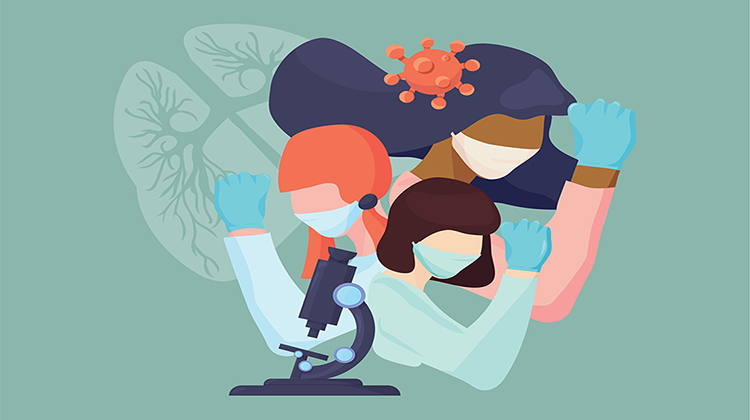Women in Stem with Joanne Kanaan
Posted: 11 June 2024 | Dr Joanne Kanaan (Omini) | No comments yet
Introducing Joanne Kanaan, CEO and co-founder of the French startup Omini. To meet the new challenges of decentralised and personalised healthcare, Omini is developing a multiplex blood testing platform for outpatient management using a new patented biosensor technology. Joanne obtained a PhD in biochemistry and biophysics from the Ecole Normale Supérieure de Paris, before reorienting herself towards entrepreneurship and innovation.


Can you tell us about your journey in the field of STEM and the challenges you encountered along the way?
I knew I’d be heading into STEM from a very young age. When choosing my bachelor’s degree, the choice was between pursuing a career in biology or in computer science. Biology won that battle, and I pursued a bachelor’s and master’s degree in biochemistry and molecular biology. As my studies were in Lebanon, one of the challenges I faced was the low funding dedicated to fundamental sciences in my home country. We had to pursue our research work with very limited resources and resolve to some creative solutions to get our experiments done, sometimes we even had to buy some of the reagents ourselves. Lack of funding was also an issue when deciding to pursue a PhD, which is why I applied for a scholarship in France where I did a PhD in biochemistry and biophysics.
After my PhD, I wanted to keep a foot in STEM but did not see myself pursuing a classical research career. I found a fit in becoming a deeptech entrepreneur, using my scientific acumen to build a medtech company and meet unmet medical needs with scientific innovation.
What inspired you to pursue a career in STEM, and how did you overcome any obstacles or biases you may have faced?
My interest in STEM came from a natural curiosity into how things work, as well as from my parents and grandfather who did STEM studies (physics, biology, engineering). I was both interested in the micro and macro, from how cells work to how the universe was expanding and how planes fly.
I had my first scientific encyclopaedia around the age of seven.
Biomarkers are redefining how precision therapies are discovered, validated and delivered.
This exclusive expert-led report reveals how leading teams are using biomarker science to drive faster insights, cleaner data and more targeted treatments – from discovery to diagnostics.
Inside the report:
- How leading organisations are reshaping strategy with biomarker-led approaches
- Better tools for real-time decision-making – turning complex data into faster insights
- Global standardisation and assay sensitivity – what it takes to scale across networks
Discover how biomarker science is addressing the biggest hurdles in drug discovery, translational research and precision medicine – access your free copy today
Thanks to my parents support I never felt any gender or societal bias. Gender was never a topic when talking about my career prospects, and my parents were willing to pay beyond their means to make sure I got the best education.
However, one of the biases I faced in fundamental research is the lack of understanding or recognition of the work we do. For instance, in my field, people easily understand the value a medical doctor brings, but few appreciate the essential role biochemistry plays in understanding how the body works, how diseases start, how drugs are discovered, etc.
Today as a medtech founder, I face other biases and challenges, especially when looking for funding for our company as my cofounder and I both come from STEM backgrounds, and we are both women. While the funding landscape did improve over the past five years, women-led startups are still under-funded, and it is not easy to convince investors that people from STEM also have the ability to acquire business and management acumen.
Could you share an example of a specific project or research that you have worked on and the impact it has had in your field?
My PhD work was focused on understanding how different helicases – small machines that unwind DNA and RNA – work and characterise them using biochemistry and biophysics tools. Thanks to our work, we managed to understand how small genetic differences can have a big impact on the binding ability of helicases to their target, and thus how mutations of helicases lead to different human disease.
In my current work, I am the CEO of our startup, where we are developing a portable multiplex blood testing platform to monitor chronic diseases like heart failure. My background in biochemistry and biophysics allowed me to understand the biosensor technology my cofounder Anna was working on, and to match an unmet medical need with it. While I no longer perform experimental work, I participate in designing our roadmap to move our technology forward into a product. My job also involves translating our complex research work into something that both doctors and investors can understand.
How has your research in STEM contributed to advancements or improvements in your field, and what potential future applications or implications do you foresee based on your work?
The product we are developing at OMINI is unique. It combines a portable connected reader with single use multiplex blood testing strips that can measure multiple biomarkers from a drop of blood. In the case of heart failure for example, we are developing a strip that measures four key blood biomarkers for heart failure monitoring and therapy management. Thanks to our work, the device will be usable in community care and at home, making sure patients remain stable and outside hospitals.
Our technology is a platform that can be further tuned to address a variety of diseases where multiplex monitoring is needed.
As a woman in STEM, what unique perspectives or strengths do you believe you bring to your work?
Whether a man or a woman, I think that having a STEM background gives unique problem-solving skills, high resilience to failure, and a framework to tackle issues differently. In STEM, we are trained to both look for as much information as possible, but to also follow hunches and intuitions, otherwise no new discoveries would be made.
This unique skillset combination is very handy in my role as an early stage startup founder where we face the unknown regularly, and have to deal with rejection from investors, hurdles in our tech development, a very steep learning curve, etc.
What advice would you give to young women who are considering a career in STEM but may be hesitant due to societal stereotypes or perceived challenges?
Societal stereotypes, unfortunately, persist across various dimensions, including race, gender, and physical appearance. However, these stereotypes should not dictate our self-esteem or limit our abilities. It’s crucial to cultivate a circle of support comprising individuals who affirm your worth and foster a sense of safety. Additionally, seek out those who challenge you intellectually and contribute to your growth through enriching dialogues.
If you’re drawn to STEM, it likely indicates a penchant for engaging debates and enlightening conversations. Prioritise relationships with those who stimulate this intellectual curiosity and help you expand your horizons. By doing so, you effectively silence the noise of stereotypes.
How do you see the representation of women in STEM changing over the years, and what further progress do you believe is needed?
The representation of women in STEM has seen a gradual but positive change over the years. In math and life and physical sciences, women now make up nearly half of the workforce. However, there’s still a notable underrepresentation in fields like computer and engineering occupations.
It is also important to note geographical disparities and try to understand where the differences stem from and what could be done differently. Central Asia and Latin America for instance have 45 to 50 percent women researchers, while Europe and US are around 25 to 35 percent of women researchers overall. Africa has a high gender gap when it comes to women in STEM, with countries like Chad having only five percent women in STEM.
In your opinion, what can organisations and institutions do to create a more inclusive and supportive environment for women pursuing STEM careers?
I believe exposure to STEM is key from a very young age. While I appreciate measures being taken to promote more women into faculty positions or leadership positions, that solution is only partial, as the main issue comes from the disparities in the initial pool of women heading into STEM, notably in STEM disciplines like engineering and computer science where women only represent 18 to 20 percent of the total student pool. Awareness work should be done in schools, getting more girls interested in sciences.
Governments could also work on educating parents to overcome some unconscious biases, for instance when choosing the toys their kids play with.
As for women who are already in STEM, flexible work arrangements, childcare support and equal pay opportunities are still needed to make sure that work-life balance is not an issue.
Looking ahead, what exciting developments or advancements do you foresee in your field of STEM, and how do you envision your own research contributing to those future innovations?
I am quite exited about new discoveries in the field of proteomics as we now have unparalleled tools to understand protein folding, identify new protein functions, and use that knowledge in drug and biomarker discovery. This leads to another set of discoveries in the field of multiomics – the integrated study of genomics, proteomics, metabolomics and other biological data – which provide a comprehensive view of an individual’s health and identify new unique biomarker signatures for which we can develop tailored monitoring devices.
About the author
Dr Joanne Kanaan, CEO and co-founder of Omini


Joanne Kanaan is the CEO and co-founder of the French startup Omini. The company is developing a multiplex blood testing platform for outpatient management using a new patented biosensor technology, to meet the new challenges of decentralised and personalised healthcare. After achieving bachelor’s and master’s degrees in biochemistry in Lebanon, Joanne obtained a PhD in biochemistry and biophysics from the Ecole Normale Supérieure de Paris, before reorienting herself towards entrepreneurship and innovation.
Related topics
Personalised Medicine
Related organisations
Omini
Related people
Dr Joanne Kanaan (Omini)







